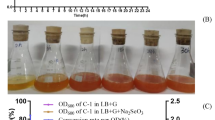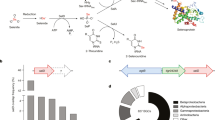Abstract
The trace element selenium (Se) is required for the biosynthesis of selenocysteine (Sec), the 21st amino acid in the genetic code, but its role in the ecology of harmful algal blooms (HABs) is unknown. Here, we examined the role of Se in the biology and ecology of the harmful pelagophyte, Aureococcus anophagefferens, through cell culture, genomic analyses, and ecosystem studies. This organism has the largest and the most diverse selenoproteome identified to date that consists of at least 59 selenoproteins, including known eukaryotic selenoproteins, selenoproteins previously only detected in bacteria, and novel selenoproteins. The A. anophagefferens selenoproteome was dominated by the thioredoxin fold proteins and oxidoreductase functions were assigned to the majority of detected selenoproteins. Insertion of Sec in these proteins was supported by a unique Sec insertion sequence. Se was required for the growth of A. anophagefferens as cultures grew maximally at nanomolar Se concentrations. In a coastal ecosystem, dissolved Se concentrations were elevated before and after A. anophagefferens blooms, but were reduced by >95% during the peak of blooms to 0.05 nM. Consistent with this pattern, enrichment of seawater with selenite before and after a bloom did not affect the growth of A. anophagefferens, but enrichment during the peak of the bloom significantly increased population growth rates. These findings demonstrate that Se inventories, which can be anthropogenically enriched, can support proliferation of HABs, such as A. anophagefferens through its synthesis of a large arsenal of Se-dependent oxidoreductases that fine-tune cellular redox homeostasis.
Similar content being viewed by others
Log in or create a free account to read this content
Gain free access to this article, as well as selected content from this journal and more on nature.com
or
References
Anderson DM, Burkholder JM, Cochlan WP, Glibert PM, Gobler CJ, Heil CA et al (2008). Harmful algal blooms and eutrophication: examples of linkages from selected coastal regions of the United States. Harmful Algae 8: 39–53.
Anderson DM, Kulis DM, Cosper EM . (1989). Immunofluorescent detection of the ‘brown tide’ organism, Aureococcus anophagefferens. In: Cosper EM, Bricelj VM, Carpenter EJ, (edn) Novel phytoplankton blooms: Causes and impacts of recurrent Brown Tides and other unusual blooms Lecture notes on coastal and estuarine studies. Springer-Verlag, p 213–228.
Baines SB, Fisher NS . (2001). Interspecific differences in the bioconcentration of selenite by phytoplankton and their ecological implications. Mar Ecol Prog Ser 213: 1–12.
Band-Schmidt CJ, Morquecho L, Lechuga-Deveze CH, Anderson DM . (2004). Effects of growth medium, temperature, salinity and seawater source on the growth of Gymnodinium catenatum (Dinophyceae) from Bahia Concepcion, Gulf of California, Mexico. J Plankton Res 26: 1459–1470.
Berry MJ, Banu L, Chen YY, Mandel SJ, Kieffer JD, Harney JW et al (1991). Recognition of UGA as a selenocysteine codon in type I deiodinase requires sequences in the 3′ untranslated region. Nature 353: 273–276.
Bodek I, Lyman WJ, Reehl WF, Rosenblatt DH . (1988) Environmental inorganic chemistry: properties, processes, and estimation methods. Pergamon Press: New York, NY, USA.
Bruland KW . (1980). Oceanographic distribution of cadmium, nickel, and copper in the North Pacific. Earth Planet Sci Lett 47: 176–198.
Caperon J, Meyer J . (1972). Nitrogen-limited growth of marine phytoplankton. II Uptake kinetic and their role in nutrient growth of phytoplankton. Deep-Sea Res 19: 619–632.
Cappon CJ . (1991). Sewage sludge as a source of environmental selenium. Sci Total Environ 100: 177–205.
Caron DA, Gobler CJ, Buck NJ, Lonsdale DJ, Cerrato RM, Schaffner RA et al (2004). Microbial herbivory on the brown tide algal, Aureococcus anophagefferens: results from natural ecosystems, mesocosms and laboratory experiments. Harmful Algae 3: 439–457.
Cosper EM, Dennison WC, Carpenter EJ, Bricelj VM, Mitchell JG, Kuenstner SH et al (1987). Recurrent and persistent ‘brown tide’ blooms perturb coastal marine ecosystem. Estuaries 10: 284–290.
Cutter GA . (1982). Selenium in Reducing Water. Science 217: 829–831.
Cutter GA . (1983). Elimination of nitrite interference in the determination of selenium by hydride generation. Anal Chim Acta 149: 391–394.
Cutter GA, Bruland KW . (1984). The marine biogeochemistry of selenium: a re-evaluation. Limnol Oceanograph 29: 1179–1192.
Cutter GA, Cutter LS . (1995). Behavior of dissolved antimony, arsenic, and selenium in the Atlantic Ocean. Mar Chem 49: 295–306.
Cutter GA, Cutter LS . (2001). Sources and cycling of selenium in the western and equatorial Atlantic Ocean. Deep-Sea Res II 48: 2917–2931.
Cutter GA, Cutter LS . (2004). Selenium biogeochemistry in the San Francisco Bay: changes in water column behaviour. Estuarine Coast Shelf Sci 61: 463–476.
Doblin MA, Blackburn SI, Hallegraeff GM . (1999). Comparative study of selenium requirements of three phytoplankton species: Gymnodinium catenatum, Alexandrium minutum (Dinophyta) and Chaetoceros cf. tenuissimus (Bacillariophyta). J Plankton Res 21: 1153–1169.
Doblin MA, Blackburn SI, Hallegraeff GM . (2000). Intraspecific variation in the selenium requirement of different geographic strains of the toxic dinoflagellate Gymnodinium catenatum. J Plankton Res 22: 421–432.
Fisher TR, Peel ER, Ammerman JW, Harding LW . (1992). Nutrient limitation of phytoplankton in Chesapeake Bay. Mar Ecol Prog Ser 82: 51–63.
Fomenko DE, Xing W, Adair BM, Thomas DJ, Gladyshev VN . (2007). High-throughput identification of catalytic redox-active cysteine residues. Science 315: 387–389.
Fries L . (1982). Selenium stimulates growth of marine macroalgae in axenic culture. J Phycol 18: 328–331.
Gobler CJ, Berry DL, Dyhrman ST, Wilhelm SW, Salamov A, Lobanov AV et al (2011). Niche of harmful alga Aureococcus anophagefferens revealed through ecogenomics. Proc Natl Acad Sci USA 108: 4352–4357.
Gobler CJ, Donat JR, Consolovo JA, Sañudo-Wilhelmy SA . (2002). Physicochemical speciation of iron during coastal algal blooms. Mar Chem 77: 71–89.
Gobler CJ, Sañudo-Wilhelmy SA . (2001). Temporal variability of groundwater seepage and Brown Tide bloom in a Long Island embayment. Mar Ecol Prog Ser 217: 299–309.
Gobler CJ, Sunda WG . (2012). Ecosystem disruptive algal blooms of the brown tide species, Aureococcus anophagefferens and Aureoumbra lagunensis. Harmful Algae 14: 36–45.
Harrison PJ, Yu PW, Thompson PA, Price NM, Phillips DJ . (1988). Survey of selenium requirements in marine Phytoplankton. Mar Ecol Prog Ser 47: 89–96.
Hatfield DL, Gladyshev VN . (2002). How selenium has altered our understanding of the genetic code. Mol Cell Biol 22: 3565–3576.
Heisler J, Glibert PM, Burkholder JM, Anderson DM, Cochlan W, Dennison WC et al (2008). Eutrophication and harmful algal blooms: a scientific consensus. Harmful Algae 8: 3–13.
Imai I, Itakura S, Matsuyama Y . (1996). Selenium requirement for growth of a novel red tide flagellate Chattonella verruculosa (Raphidophyceae) in culture. Fisheries Sci 62: 834–835.
Keller M, Guillard RRL, Provasoli L, Pintner IJ . (1984). Nutrition of some marine ultraplankton clones from the Sargasso Sea. EOS 65: 898.
Kim HY, Fomenko DE, Yoon YE, Gladyshev VN . (2006). Catalytic advantages provided by selenocysteine in methionine-s-sulfoxide reductases. Biochem 45: 13697–13704.
LaRoche J, Nuzzi R, Waters R, Wyman K, Falkowski PG, Wallace DWR . (1997). Brown tide blooms in Long Island’s coastal waters linked to variability in groundwater flow. Global Change Biol 3: 397–410.
Lee YS . (2008). Utilization of various nitrogen, phosphorus, and selenium compounds by Cochlodinium polykrikoides. J Environ Biol 29: 799–804.
Lindstrom K . (1991). Nutrient requirements of the dinoflagellate Peridinium gatunense. J Phycol 27: 207–219.
Lobanov AV, Fomenko DE, Zhang Y, Sengupta A, Hatfield DL, Gladyshev VN . (2007). Evolutionary dynamics of eukaryotic selenoproteomes: large selenoproteomes may associate with aquatic and small with terrestrial life. Genome Biol 8: R198.
Lobanov AV, Hatfield DL, Gladyshev VN . (2009). Eukaryotic Selenoproteins and selenoproteomes. Biochim Biophys Acta 1790: 1424–1428.
McBride MB, Spiers G . (2001). Trace element content of selected fertilizers and dairy manures as determined by ICP-MS. Comm Soil Sci Plant Anal 32: 139–156.
Measures CI, Grant B, Khadem M, Edmond JM . (1984). Distribution of Be, Al, Se and Bi in the surface waters of the western North Atlantic and Caribbean. Earth Planet.Sci Lett 71: 1–12.
Milligan AJ, Cosper EM . (1997). Growth and photosynthesis of the ‘brown tide’ microalga Aureococcus anophagefferens in subsaturating constant and fluctuating irradiance. Mar Ecol Prog Ser 153: 67–75.
Mitrovic SM, Amandi MF, McKenzie L, Furey A, James KJ . (2004). Effects of selenium, iron and cobalt addition to growth and yessotoxin production of the toxic marine dinoflagellate Protoceratium reticulatum in culture. J Exp Mar Biol Ecol 313: 337–351.
Mountfort D, Beuzenberg V, MacKenzie L, Rhodes L . (2006). Enhancement of growth and gymnodimine production by the marine dinoflagellate, Karenia selliformis. Harmful Algae 5: 658–664.
Novoselov SV, Lobanov AV, Hua D, Kasaikina MV, Hatfield DL, Gladyshev VN . (2007). A highly efficient form of the selenocysteine insertion sequence element in protozoan parasites and its use in mammalian cells. Proc Natl Acad Sci USA 104: 7857–7862.
Novoselov SV, Rao M, Onoshko NV, Zhi H, Kryukov GV, Xiang Y et al (2002). Selenoproteins and selenocysteine insertion system in the model plant cell system. Chlamydomonas reinhardtii. EMBO J 21: 3681–3693.
Palenik B, Grimwood J, Aerts A, Rouzé P, Salamov A, Putnam N et al (2007). The tiny eukaryote Ostreococcus provides genomic insights into the paradox of plankton speciation. Proc Natl Acad Sci USA 104: 7705–7710.
Parsons TR, Maita Y, Lalli CM . (1984) A manual of chemical and biological methods for seawater analysis. Pergamon.
Puls RW, Paul CJ . (1995). Low-flow purging and sampling of ground water monitoring wells with dedicated systems. Ground Water Monitoring Rev 15: 116–123.
Schubert CE . (1998) Areas contributing ground water to the Peconic Estuary, and ground-water budgets for the North and South Forks and Shelter Island, Eastern Suffolk County. Geological Survey Water Resources Investigations Report: New York, NY, USA, 97–4136.
Stadtman TC . (1996). Selenocysteine. Ann Rev Biochem 65: 83–100.
US EPA (2009) Targeted National Sewage Sludge Survey Report—Overview. EPA, 822-R-08-014.
Waring J, Klenell M, Bechtold U, Underwood GJC, Baker NR . (2010). Light-induced responses of oxygen photoreduction, reactive oxygen species production and scavenging in two diatom species. J Phycol 46: 1206–1217.
Wheeler AE, Zingaro RA, Irgolic K, Bottino NR . (1982). The effect of selenate, selenite and sulfate on the growth of six unicellular marine algae. J Exp Mar Biol Ecol 57: 181–194.
Acknowledgements
This study was supported by awards from National Oceanic and Atmospheric Administration Center for Sponsored Coastal Ocean Research award no. NA09NOS4780206 to CJG, NIH grant GM061603 to VNG and Peconic Estuary Program Office (Suffolk County Department of Health Services contract no. 525-8228-0113-00-00001) to GTT and SASW.
Author information
Authors and Affiliations
Corresponding authors
Additional information
Supplementary Information accompanies this paper on The ISME Journal website
Supplementary information
Rights and permissions
About this article
Cite this article
Gobler, C., Lobanov, A., Tang, YZ. et al. The central role of selenium in the biochemistry and ecology of the harmful pelagophyte, Aureococcus anophagefferens. ISME J 7, 1333–1343 (2013). https://doi.org/10.1038/ismej.2013.25
Received:
Revised:
Accepted:
Published:
Issue date:
DOI: https://doi.org/10.1038/ismej.2013.25
Keywords
This article is cited by
-
The algal selenoproteomes
BMC Genomics (2020)
-
Selenium strikes back at fungi
Nature Microbiology (2019)
-
Density Functional Theory Study of Cyanoetheneselenol: A Molecule of Astrobiological Interest
Origins of Life and Evolution of Biospheres (2015)



